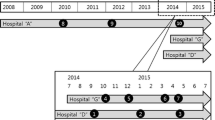Abstract
In response to several isolations of methicillin-resistant Staphylococcus aureus carrying the Panton-Valentine leucocidin gene (PVL-MRSA), the present study was conducted to document the spread of infection in a small region of southeastern Germany. During a 9-month period, two healthcare-associated outbreaks with PVL-MRSA occurred, affecting 83 patients, personnel and contacts of personnel, and 34 additional cases were detected in the community. The clinical spectrum ranged from colonization to skin infection and necrotizing pneumonia. The findings represent the largest number of PVL-MRSA cases detected in Germany so far, and demonstrate the potential of this emerging pathogen to spread within the community and in healthcare institutions.
Similar content being viewed by others
References
Witte W, Cuny C, Strommenger B, Braulke C, Heuck D (2004) Emergence of a new community acquired MRSA strain in Germany. Euro Surveill 9:1–2
Vandenesch F, Naimi T, Enright MC, Lina G, Nimmo GR, Heffernan H, Liassine N, Bes M, Greenland T, Reverdy ME, Etienne J (2003) Community-acquired methicillin-resistant Staphylococcus aureus carrying Panton-Valentine leukocidin genes: worldwide emergence. Emerg Infect Dis 9:978–984
Lina G, Piemont Y, Godail-Gamot F, Bes M, Peter MO, Gauduchon V, Vandenesch F, Etienne J (1999) Involvement of Panton-Valentine leukocidin-producing Staphylococcus aureus in primary skin infections and pneumonia. Clin Infect Dis 29:1128–1132
Anonymous (1999) Four pediatric deaths from community-acquired methicillin-resistant Staphylococcus aureus: Minnesota and North Dakota, 1997–1999. MMWR 48:707–710
Saiman L, O’Keefe M, Graham III PL, Wu F, Said-Salim B, Kreiswirth B, LaSala A, Schlievert PM, Della-Latta P (2003) Hospital transmission of community-acquired methicillin-resistant Staphylococcus aureus among postpartum women. Clin Infect Dis 37:1313–1319
Baba T, Takeuchi F, Kuroda M, Yuzawa H, Aoki K, Oguchi A, Nagai Y, Iwama N, Asano K, Naimi T, Kuroda H, Cui L, Yamamoto K, Hiramatsu K (2002) Genome and virulence determinants of high virulence community-acquired MRSA. Lancet 359:1819–1827
Ma XX, Ito T, Tiensasitorn C, Jamklang M, Chongtrakool P, Boyle-Vavra S, Daum RS, Hiramatsu K (2002) Novel type of staphylococcal cassette chromosome mec identified in community-acquired methicillin-resistant Staphylococcus aureus strains. Antimicrob Agents Chemother 46:1147–1152
National Committee for Clinical Laboratory Standards (1999) Performance standards for antimicrobial disk susceptibility testing. Ninth informational supplement. M100-S9. NCCLS, Villanova, PA
Skov R, Frimodt-Moller N, Espersen F (2001) Correlation of MIC methods and tentative interpretive criteria for disk diffusion susceptibility testing using NCCLS methodology for fusidic acid. Diagn Microbiol Infect Dis 40:111–116
Reischl U, Linde HJ, Metz M, Leppmeier B, Lehn N (2000) Rapid identification of methicillin-resistant Staphylococcus aureus and simultaneous species confirmation using real-time fluorescence PCR. J Clin Microbiol 38:2429–2433
Robinson DA, Enright MC (2004) Multilocus sequence typing and the evolution of methicillin-resistant Staphylococcus aureus. Clin Microbiol Infect 10:92–97
Salgado CD, Farr BM, Calfee DP (2003) Community-acquired methicillin-resistant Staphylococcus aureus: a meta-analysis of prevalence and risk factors. Clin Infect Dis 36:131–139
Okuma K, Iwakawa K, Turnidge JD, Grubb WB, Bell JM, O’Brien FG, Coombs GW, Pearman JW, Tenover FC, Kapi M, Tiensasitorn C, Ito T, Hiramatsu K (2002) Dissemination of new methicillin-resistant Staphylococcus aureus clones in the community. J Clin Microbiol 40:4289–4294
Witte W (2004) Community acquired MRSA weltweit und in Deutschland. Epidemiologisches Bulletin 5:33–37
Acknowledgments
We thank E. Kleingütl (Institut für Medizinische Mikrobiologie, Universität Regensburg, Regensburg, Germany) and D. Döring (Altenheim Pro-Seniore, Straubing, Germany) for assistance in the screening of outbreak I. We thank Dr. med. F. Buchwald (synlab, Weiden, Germany), Dr. med. J. Huber (Klinikum Deggendorf, Deggendorf, Germany) and Dr. med. J. Matthes (Miclab GmbH, Neuötting, Germany) for provision of isolates. We thank M. Werkmann (Mikrobiologisches Labor, Klinikum Straubing, Germany) for laboratory assistance in the screening of outbreak I
Author information
Authors and Affiliations
Corresponding author
Rights and permissions
About this article
Cite this article
Linde, H., Wagenlehner, F., Strommenger, B. et al. Healthcare-associated outbreaks and community-acquired infections due to MRSA carrying the Panton-Valentine leucocidin gene in southeastern Germany. Eur J Clin Microbiol Infect Dis 24, 419–422 (2005). https://doi.org/10.1007/s10096-005-1341-7
Published:
Issue Date:
DOI: https://doi.org/10.1007/s10096-005-1341-7




